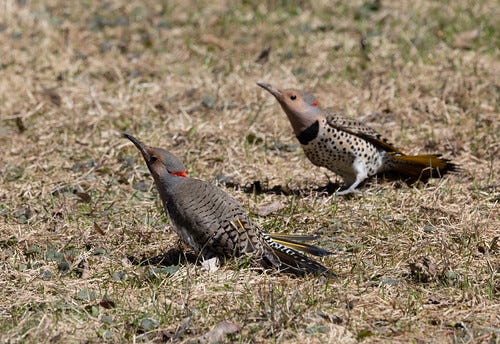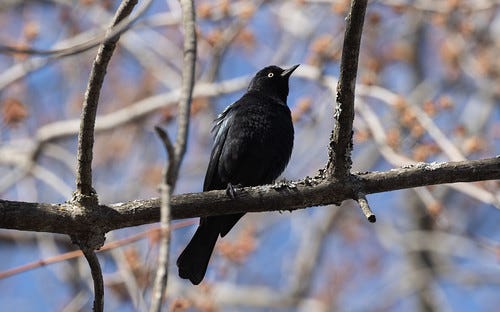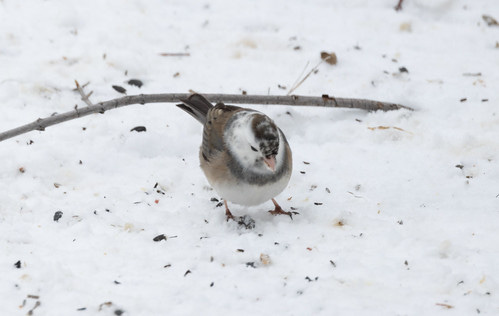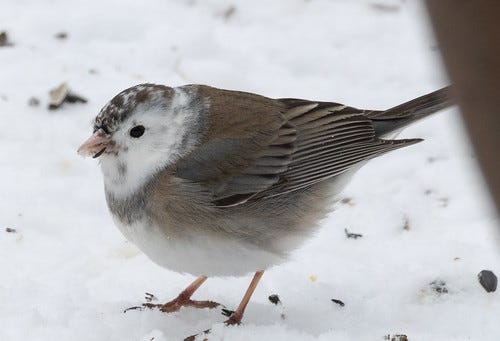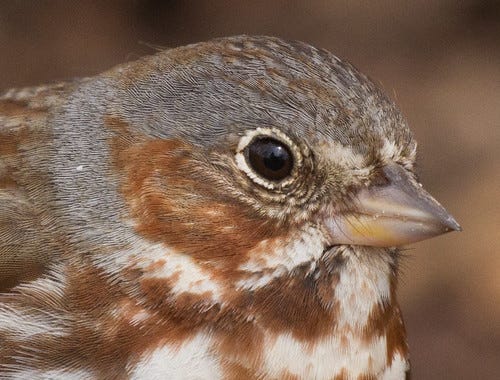Spring Update
The expected and the unexpected
(Listen to the radio version here.)
This is the 49th spring migration I’ve witnessed as a birder, all in the Upper Great Lakes except for the three when I was in Ithaca, New York, which isn’t much different bird-wise. You’d think it would get boring seeing the same birds doing the same thing over and over, year after year—after all, bird migration is one of the most predictable occurrences on earth. But that predictability is also warmly reassuring.
We may know within days or at least a week or two when most species will arrive, yet every spring manages to be entirely different, too. I was traveling for four days last week and missed some exceptional birding at home, including Snowy and Great Egrets, pelicans, Snow Geese, and an early Solitary Sandpiper. Farthest out of range were a Say’s Phoebe at Stoney Point north of Duluth and an Eared Grebe at Brighton Beach.
Early migrants must be flexible to survive, sometimes even turning tail and heading south in what is called reverse migration when conditions grow too tough. With so much snow this March and April, several birders have witnessed this along the Lake Superior shoreline. On April 18, long-time Minnesota bird authority Janet Green, with her husband and daughter from their apartment on the shore, counted at least 10,000 birds per hour for a total of between 50,000 and 100,000. She wrote:
Species were mostly blackbirds (Rusty BB and grackles dominate), finches, sparrows, robins, flickers, [Yellow-rumped Warblers] and other passerines… I have been living and birding the North Shore since the 1960's, and seen lots of reverse migration in the spring but never before at this magnitude.
I first saw a flicker in my yard on April 11. Flickers specialize on eating ants, which aren't crawling around much yet, so the birds are sticking to a few tried-and-true spots in my yard where they can insert their beaks into an ant colony, extend their long, sticky tongues down a narrow tunnel, and pull out sustenance. They're skittish, but I did manage to get a few fairly close photos.
While a male was feeding not too far from my open window, a female flew in toward him. (Adult females lack the black “mustache” mark.) He raised his head and spread his tail a bit when she arrived, but then returned to feeding. She apparently decided that spot belonged to him and flew off.
Usually, I have a lot of Common Grackles by now, but so far this year I’ve had just three at the most. Instead, I’ve been getting a flock of about 25 Rusty Blackbirds.
Their delicate build belies their hardiness, breeding in swamps and tundra wetlands throughout Canada and Alaska. Their population dropped precipitously—at least 75 percent—between about 1966 and 2019. The causes are not straightforward but most assuredly include warmer temperatures drying up some of their nesting bogs and swamps and changing vegetation patterns. Also, in the agricultural states where they winter, the mixed blackbird flocks they join are often poisoned by farmers.
In all my years living in Duluth, I’ve never had more than two or three Rusty Blackbirds at a time before, but like many birds, their migration concentrates along Lake Superior and they associate in flocks, so my seeing two dozen is hardly evidence of a sudden population surge. Nevertheless, seeing so many more than usual feels hopeful.
Fox Sparrows are the birds singing most right now, but I’m seeing an order of magnitude more juncos. Last week an aberrant one with a lot of white on the head and face mingled with the others.
(In ornithology classes in the mid-1970s, I learned that type of patchwork plumage was called “partial albinism,” but currently ornithologists seem to be calling any odd paler-than-normal, patchy white, or even fully white birds the catch-all term “leucistic.”)
With the pandemic, I spent the past three springs rooted to home, and needing to do something new, I started making bird sound recordings in my backyard. This month we’ve had so many windy days that I haven’t set out my recorder much, but on Tuesday, I did and got some great Fox Sparrow and Rusty Blackbird sounds. Two flickers were hanging around near my recorder, but were too busy searching for food to call.
For me, listening to my sound recordings immerses my memory more fully back into a place and time than seeing my photographs. The recording I did on the 18th will remain a treasure that I can listen to whenever I’m hungry for a yard full of exciting migrants. I haven’t finished editing the 4-hour recording to delete car, plane, and dog noise, but I did post a nice 14-minute snippet here. That and quite a few of my favorite long recordings for pleasant listening are posted here, where anyone can download them. I don’t earn money for my bird recordings, but then, birds never get compensated for their talents, either.







